Replacing a Korg Polyphonic Ensemble FK-4 Pedal (DIN5 Connector) with an XVP-10 or Other Standard Expression Pedal (TRS Connector)
For use with Polyphonic Ensemble PE-2000 (Volume) / PE-1000 (Traveler)
- Terre Thaemlitz
|


January 3, 2015 (comatonse.com).


Sorry, I don't usually post geeky technical stuff on this website, but I thought this particular bit of information will be useful to those very few people who own a Korg Polyphonic Ensemble PE-2000 keyboard (also known as Polyphonic Ensemble S in some countries), or a Polyphonic Ensemble PE-1000 (a.k.a. Polyphonic Ensemble P), and wish to use the DIN5 pedal connection on back but do not have a rare FK-4 controller pedal. This page assumes you have a general understanding of cable building and soldering.
I recently picked up a PE-2000, and wished to utilize the DIN5 pedal input in back. Both the PE-2000 and PE-1000 were designed to work with a Korg Polyphonic Ensemble FK-4 pedal, which features the DIN5 connector and a foot switch. Because FK-4 pedals are hard to find, relatively expensive (I recently saw one sell on ebay for almost half the cost of what I paid for the PE-2000 itself), and so old that they may not work anyway, I decided to look into the possibility of connecting the PE-2000's DIN5 pedal jack to a standard expression pedal with a TRS (stereo 1/4-inch) connection, such as a Korg XVP-10.
I am very pleased to say it is possible!
I am even more pleased to say the total cost for parts to build the cable was under ¥500 (under $5.00 USD / €5,00).
I will explain how to properly wire your own DIN5-to-TRS cable, as well as detail some of my findings. As I only own a PE-2000, and do not own a PE-1000, my tests were limited to the PE-2000. However, based on those results as well as reading the PE-1000 manual and schematics, I believe I have found the correct wiring solutions for both keyboards.


|
What You Will Need
|

- x1 DIN5 connector
- x1 TRS (1/4-inch Stereo) connector
- 2m 3-wire cable (or desired length)
* Note: 3-wire cable is adequate for a basic FK-4 "Switch On" type connection. More elaborate wirings are also discussed which require additional wires and an A/B switch. Purchase according to your configuration needs.


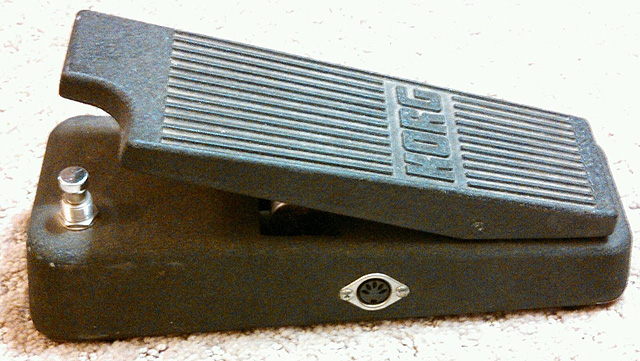
Photo from an Ebay auction.
I was initially wondering if the silver button switch on the FK-4 pedal activated multiple functions that necessitated wiring more complex than the three lines offered on a TRS plug. However, after looking long and hard at the schematics, things turned out to be simpler than they first appeared. The button appears to be a simple "On/Off" switch, and equivalent wirings for both switch positions can be accomplished with 3 lines - exactly the number on a TRS jack.
I physically verified this on the PE-2000 by testing various DIN5-to-TRS wiring schemes that emulated the FK-4's two switch positions. The cables were tested with Korg XVP-10 and Boss FV-300L expression pedals. The "Switch On" wiring scheme resulted in volume control with both pedals, and the "Switch Off" wiring scheme resulted in no changes to the volume or anything else.
I also confirmed that there was no apparent change in sound quality, nor additional line noise, simply by having the "Switch On" cable plugged into the PE-2000 with the TRS expression pedals in a "Full Volume" position (in case this was another techncial purpose for the "On/Off" switch, as hypothesized by a friend who works at Korg Japan).
Since the FK-4's "On/Off" switch only seems to be there for convenience (at least when used with the PE-2000), and if I really want to "Switch Off" the expression pedal I can simply unplug the cable from the PE-2000, I concluded that a single cable permanently wired to the "Switch On" position is good enough for my personal needs:
PE-2000 "FK-4 Switch Always On" Cable
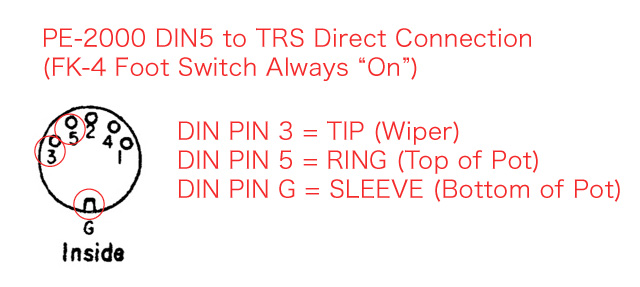
Note: "Inside" refers to the inside view (rear) of the keyboard's DIN port. It is identical to looking head on at the pins on the finished cable, and the mirror opposite of where you will solder the wires inside the cable.
On the PE-1000 the wiring of the ground (bottom of pot) is slightly different, swapping pin G to pin 2:
PE-1000 "FK-4 Switch Always On" Cable
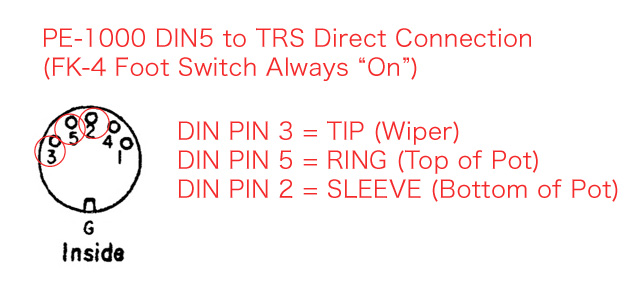
Note: "Inside" refers to the inside view (rear) of the keyboard's DIN port. It is identical to looking head on at the pins on the finished cable, and the mirror opposite of where you will solder the wires inside the cable.
When connected to a PE-1000, the "Switch On" cable should allow a TRS expression pedal to control the Traveler (not volume):

PE-1000 Owner's Manual explanation of FK-4 pedal functionality.
For those lucky enough to have both a PE-2000 and PE-1000, a single "Switch On" cable that will work with either model is also possible:
Universal "FK-4 Switch Always On" Cable for PE-2000 and PE-1000
* Note: Although this cable has four leads, it can still be built using 3-wire cable. Simply cut a very short section of ground wire and connect DIN pin 2 to DIN pin G directly inside of the DIN5 connector. The other option is to use 4-wire cable and run DIN pin 2 all the way to the TRS Sleeve, but this is technically unnecessary.
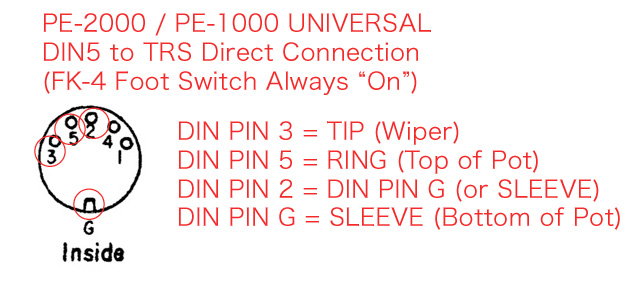
Note: "Inside" refers to the inside view (rear) of the keyboard's DIN port. It is identical to looking head on at the pins on the finished cable, and the mirror opposite of where you will solder the wires inside the cable.
My only uncertainty is whether or not the FK-4's "On/Off" switch has any relationship to the actual upper Traveler slider on the PE-1000 (ie., is the PE-1000's upper Traveler slider disabled when the FK-4 pedal is switched "On"?). If so, I imagine having an "On/Off" switch for the expression pedal would be desirable so that you could easily switch between controlling the Traveler with the slider and pedal. (The alternative, of course, is just to unplug the "Switch On" cable when wanting to use the slider - which should be good enough in a studio environment, put probaby not in a live setting.) Inserting the "On/Off" capability is easily achieved with a slight wiring modification and insertion of an inline A/B switch as follows (this "On/Off" cable will also work with the PE-2000):
Universal "FK-4 On/Off Switch" Cable for PE-2000 and PE-1000
* Note: This wiring pattern requires and A/B Switch and at least 4-wire cable (assuming DIN pin 2 is connected by short wire to DIN pin G directly within the DIN5 connector - otherwise use 5-wire cable if you choose to run DIN pin 2 all the way to the TRS Sleeve).
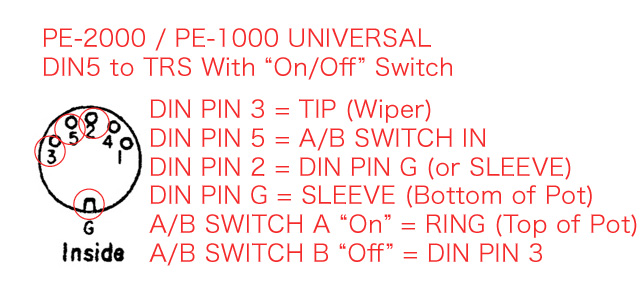
Note: "Inside" refers to the inside view (rear) of the keyboard's DIN port. It is identical to looking head on at the pins on the finished cable, and the mirror opposite of where you will solder the wires inside the cable.


|
Pots & Performance
|
The FK-4 contains a 10K pot. Therefore, for accurate emulation of an FK-4 one would ideally use a TRS expression pedal with a 10K pot. The XVP-10 has a 50K pot, and I have not been able to determine the size of the pot on the FV-300L (various estimates found online were unhelpful, ranging from 20K to 250K - in any case, it seems to be something different than both the FK-4 and XVP-10).
While researching this project, I noticed that people frequently debate whether or not pot size affects expression pedal performance. Those who say it should not matter argue that the pot simply scales the input signal on a slider evenly over a range from 0% to 100%, which remains unchanged regardless of the type of pot. This sounds logical, and I also originally assumed it would prove true. However, a friend at Korg explained that while pot size might not make much difference in digital gear (because the pot action is ultimately used to scale fixed digital data), pot size is more likely to make a difference with analogue gear because the pot action directly relates to the flow of current to sound circuits.
I found the performance of both the XVP-10 and FV-300L to be quite similar, despite the fact they likely have very different sized pots. With both pedals, I found that the majority of pedal action occurred in the top half of the pedal range (ie., the volume did not start to fade in until the pedal was near the half-way point). I felt the FV-300L's active Minimum Volume knob gives it a slight advantage over the XVP-10 because it allows me to set the minimum volume level of the PE-2000 to come in slightly sooner once the pedal reaches the range where audible pot action begins. However, the difference is not so notable that it warrants going out and buying an FV-300L if you already have another TRS expression pedal.
Although I have no FK-4 or other pedal with a 10K pot to compare with my XVP-10 or FV-300L, it is possible that using a pedal with a 10K pot would produce a smoother curve spanning the entire pedal range. (But then again, the fact that two pedals with presumably quite different pots performed nearly identically could mean that the pot size does not matter, and the fact that most of the pedal action happens in the top half of the pedal range could just be part of the Polyphonic Ensemble's character.)


|
Top of Pot and Wiper Polarity (Tip vs. Ring) Doesn't Seem to Matter
|
Different manufacturers of expression pedals using TRS connections use different wiring schemes, with some connecting the Wiper to the Tip, and others connecting the Wiper to the Ring. (Hint: If you have an old TRS expression pedal that you can't seem to get to work with your gear, and it is a different brand than the gear you are plugging it into, you might get it to work by simply swapping Tip and Ring positions.) However, in the case of the PE-2000 (and I assume the PE-1000), Tip and Ring polarity do not seem to make any difference. In fact, according to the polarity chart below, the Korg XVP-10 and Boss (Roland) FV-300L are wired differently - yet I found they performed identically.

Taken from: http://www.marichiba.com/how-to-replace-roland-ev-5-expression-pedal-with-yamaha-fc7
For posterity's sake, I decided to try swapping my cable's Tip and Ring connections and test both pedals in all four possible combinations:
Standard Wiring (as explained above)
- Switch On: (DIN 3 | DIN 5 | DIN G) = (R | T | S)
- Switch Off: (DIN 3 | DIN 5 | DIN G) = (R | DIN 3 | S)
Reverse Wiring
- Switch On: (DIN 3 | DIN 5 | DIN G) = (T | R | S)
- Switch Off: (DIN 3 | DIN 5 | DIN G) = (T | DIN 3 | S)
In both wiring patterns, and with both pedals, "Switch On" and "Switch Off" performance was always identical with the PE-2000. "Switch On" controlled volume in the normal foot pedal manner, and "Switch Off" bypassed the pedal so it had no effect at all.
I thought the fact Tip and Ring didn't matter was a bit surprising, and pretty cool to know. :) But just in case, I am keeping my cable in the schematically correct DIN pin 5 to TRS Tip pattern.


|
Further Details and Explanations
|
This section is for those wishing to know how I arrived at my wiring configurations above, why I always ignore DIN pins 1 and 4, etc.
I found schematics for the PE-2000, PE-1000 and FK4 here (the FK-4's specs appear on page 11 of the PE-1000 schematic):
http://www.korganalogue.net/korgother/index.html
That same webpage also has an owner's manual for the PE-1000, but I have still not been able to find a manual for the PE-2000 anywhere. All of the information I found online regarding the FK-4's functionality was limited to use as an 'expression pedal' with the PE-1000, controlling the upper Traveler lever (VCF). Because the PE-2000 schematic refers to the "DIN Conector [sic] for Expression Pedal," I was hoping it would perform a similar 'hidden' filtering function on the PE-2000. However, this is not the case. On the PE-2000 the pedal only controls volume.
The most relevant schematic images are below.
PE-2000 DIN Connector Wiring Map & Actual View
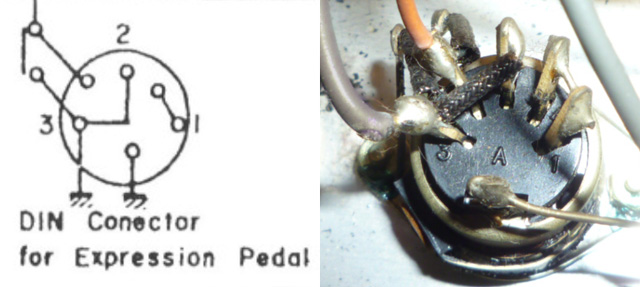
Inside view PE-2000 DIN connection schematic (left) and photo of actual connection inside my PE-2000 (right). Note the schematic indicates "DIN Conector [sic] for Expression Pedal." In reality, the pedal only controls volume on the PE-2000 - although at the time this keyboard was made the terminology was not fixed, so volume (VCA) changes may have also been categorized with filter (VCF) changes a form of "tonal expression."
PE-1000 (Left) & FK-4 (Right) DIN Connector Wiring Maps
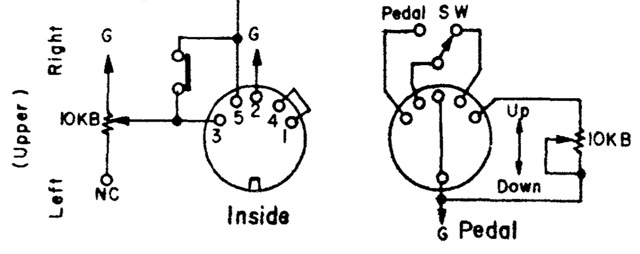
Inside view DIN connection schematics for PE-1000 (left) and FK-4 Pedal (right).
Looking at the FK-4 schematic above (using the 3/5/2/4/1/G pin numbering pattern indicated on the PE-1000 DIN inside view), the pedal switch only affects DIN pin 5.
In the "Switch On" position (Pedal SW arrow pointing to the right, as drawn), DIN pin 5 gets routed to DIN pin 4. In both the PE-2000 and PE-1000 DIN pin 4 is hard-wired to DIN pin 1, and DIN pin 1 is the hot lead out to the top of the pedal's pot (10K). In other words, DIN pins 1 and 4 are simply a routing connection opened by the pedal switch. This means that DIN pins 1 and 4 can be totally bypassed by directly connecting DIN pin 5 to the top of the pedal's pot (TRS Tip).
In the "Switch Off" position (Pedal SW arrow pointing to the left, not drawn), DIN pin 5 is routed to DIN pin 3, and the pedal's pot is bypassed entirely on both the PE-2000 and PE-1000.
Also, in the FK-4, DIN pins 2 and G are both hard-wired to each other and serve as grounds. Similarly, in both the PE-2000 and PE-1000, DIN pin 3 eventually connects to ground (in the PE-2000 it is connected by a short wire to DIN pin 2, and in the PE-1000 it connects to ground via the upper Traveler switch when no FK-4 pedal is connected or the FK-4 is in "Switch Off" mode). This means that for both keyboards, when the FK-4 is in "Switch Off" position and DIN pin 5 gets routed through DIN pin 3, DIN pin 5 also ends up connected to a ground which essentially cancels and deactivates DIN pin 5.
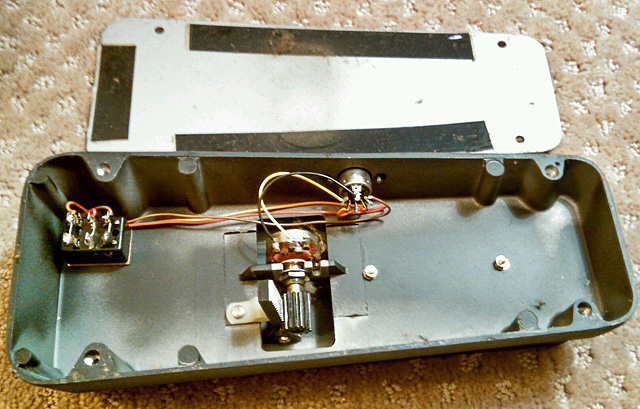
Photo from an Ebay auction.
This was all important to figure out beforehand, so as not to make a bad connection that might blow up my keyboard (in particular, I was concerned that the "Switch Off" position connecting DIN pin 5 to DIN pin 3 would cause a short - it does not). Luckily, I was able to discuss my interpretation of the schematics with a friend at Korg Japan, who also looked at them and confirmed what I was thinking (unofficially, speaking more as a friend than Korg representative). His biggest help was confirming what he believed to be the three active DIN pins for the PE-2000, which matched my own conclusions. That gave me the confidence to then start soldering cables and figure out everything else.
Although I cannot attest to the quality of this cable hack compared to the performance of an actual FK-4 (or other 10K pot) pedal, this information should allow curious Polyphonic Ensemble owners to easily and affordably access the DIN5 pedal functions with contemporary TRS pedals. After all, you can't know if a function is really useful or not until you hear it and start playing around with it - so I hope these instructions help some people discover what they've been missing. Speaking for myself, simply figuring out all of the things these old synths can do is half the fun... more than half!
|










